Chlorine Tablets are the easiest and safest way to get chlorine into your pool.
Automatic Chlorinators are the perfect partner, allowing a way to provide a constant and consistent chlorine level.
Using tablets in the skimmer? That’s a No-No, and can cause big problems over time.
Chlorine Floaters? Well OK, better than nothing, but less effective than a real, stand-alone chlorinator, aka chlorine tablet feeder. There are several benefits to using a chlorine feeder.
LESS HANDLING OF CHEMICALS
If you own a swimming pool, then it is guaranteed that your hands at one point have smelled like chlorine. Depending on the size of your pool and the levels you set the feeder to chlorinate, you can decrease the frequency of opening that big smelly bucket, breathing and touching chlorine, because you can stock it up with a 2-3 week supply. This alone makes owning an automatic chlorinator worth it. BUT WAIT! There’s more.
SAFER FOR YOUR EQUIPMENT and SURFACES
Hopefully, you are not using chlorine tablets in the skimmer basket and are aware that this can cause big problems. If your pump is off for many hours each day, tablets in a pump basket continue to dissolve and fill the skimmer with a very strong chlorine solution that can damage skimmers, pipes, filters and heaters. Some of you already know this and there are those who may say, “Why spend $100 on an automatic chemical feeder when my $20 chlorine floater does the same job?!?”
I like floaters during winter, but the problem with floaters is that they can tip over, or come to rest on a step or ladder, or drop bits of tablets to the floor which can stain the pool. Plus, they don’t allow as much control of the dissolve rate, the dial control feature of automatic chlorinators are much more precise so you don’t over or under chlorinate the pool. Automatic feeders will not only save money by extending the life of your equipment and pool surfaces, you save money by not wasting chlorine.
INEXPENSIVE TO BUY, INEXPENSIVE TO FIX:
Perhaps, you are saying to yourself, “Well, an automatic chlorinator is just one more piece of equipment I have to worry about. I can just buy another twenty dollar floater every few seasons.” The truth is that automatic chlorinators are actually pretty simple devices that do not have any electronic or complex mechanical parts. They are very low maintenance pool products, just keep the lid o-ring lubed, and for chlorinators installed off-line, replace your hoses and fittings every 3-5 years.
Hayward Chlorinators
Hayward Automatic Chlorinators are probably the most well known and ubiquitous of chlorine feeders on the market today.
Hayward Chlorinators are available for inground and above ground pools, in both In-Line and Off-Line versions. They feature a venturi standpipe to draw-in chlorinated water, which is easily cleaned, should it ever become clogged with residue.
9 lb capacity (inground models) is larger than most residential feeders.
Pentair Chlorinators
Rainbow Life-Gard (Pentair) Automatic Chlorine Feeders are also available in a variety of sizes, to hold 5lbs of stacked tablets, up to 40lbs for the largest model HC3330.
Rainbow feeders offer a simpler lid assembly, with fewer lid o-ring problems as a likely result. Small 4inch lid is easy to open, without a special wrench.
Rainbow Off-Line hoses are noticeably heavy duty, and the base plate is thicker than other feeders, and hold up to twisting force while removing a sticky lid.
Sani-King Chlorinators
Not a new player on the scene, King Technology has been patenting chlorine feeders since the early 70’s.
Sani-King Perform-Max chlorine feeders offer the patented Inline Dispersal valve, which only wets the bottom few inches of chlorine tablets, instead of flooding the entire chamber.
Frog Chlorine feeders and New Water Cyclers also use the King Control Dial Assembly, and all have the oversized dials and lids for easier removal.
In-Line or Off-Line Chlorinator?
In-Line chlorinators are plumbed in place, into the return pipe – after all other equipment, as shown in the image below-left. Plumb the chlorine feeder into a section of clear pipe, near the ground, so chlorine gas won’t back up into a heater or filter valve. You’ll need a hacksaw, measuring tape and PVC primer and glue.

Off-Line chlorinators, shown right, are used when there is no room to install an In-Line chlorinator, or not enough clear space on the return pipe, after all other equipment. 2 holes are drilled into the PVC pipe, one before the filter and one after the filter. Hoses are saddle clamped to the pipe to carry water in and out of the ‘Off-line’ or ‘Off the Pipe’ chlorine feeder.
In-Line is a better way to go, for a more sturdy installation and less parts to replace. Hoses tend to become brittle over time and injection fittings will gum-up after several years. If pipe space is tight on the return line, the Rainbow 320 In-Line model (shown here with clear chamber), requires only 4″ of pipe to install.
If you do install an Off-Line feeder, be sure to install the base into the concrete or into a heavy block of wood, to keep it steady while opening the lid.

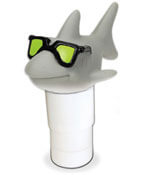
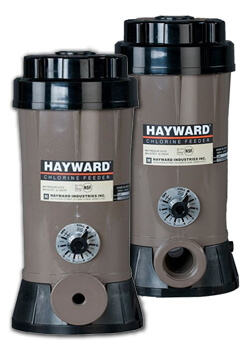
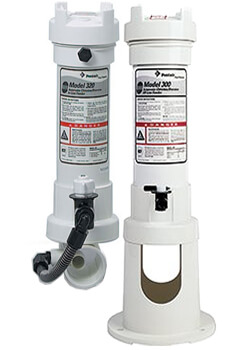

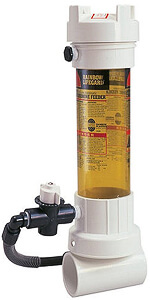

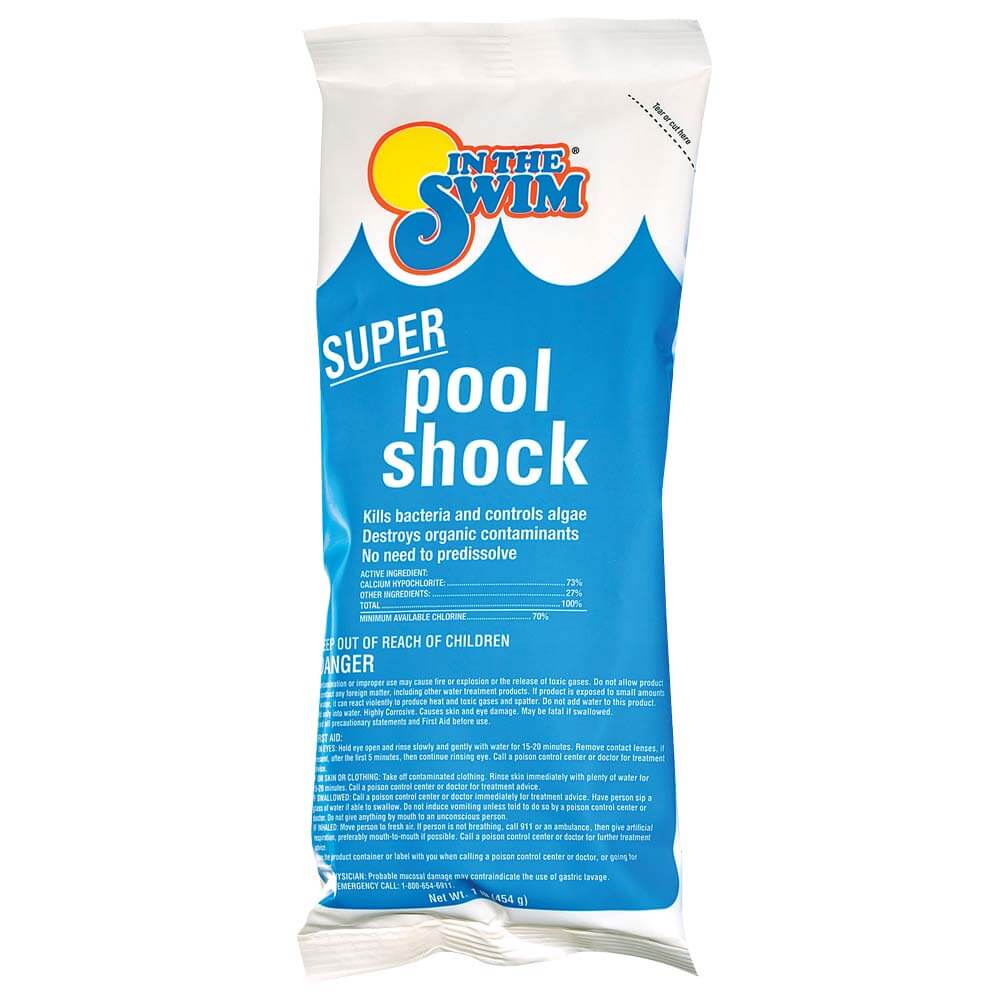
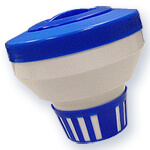


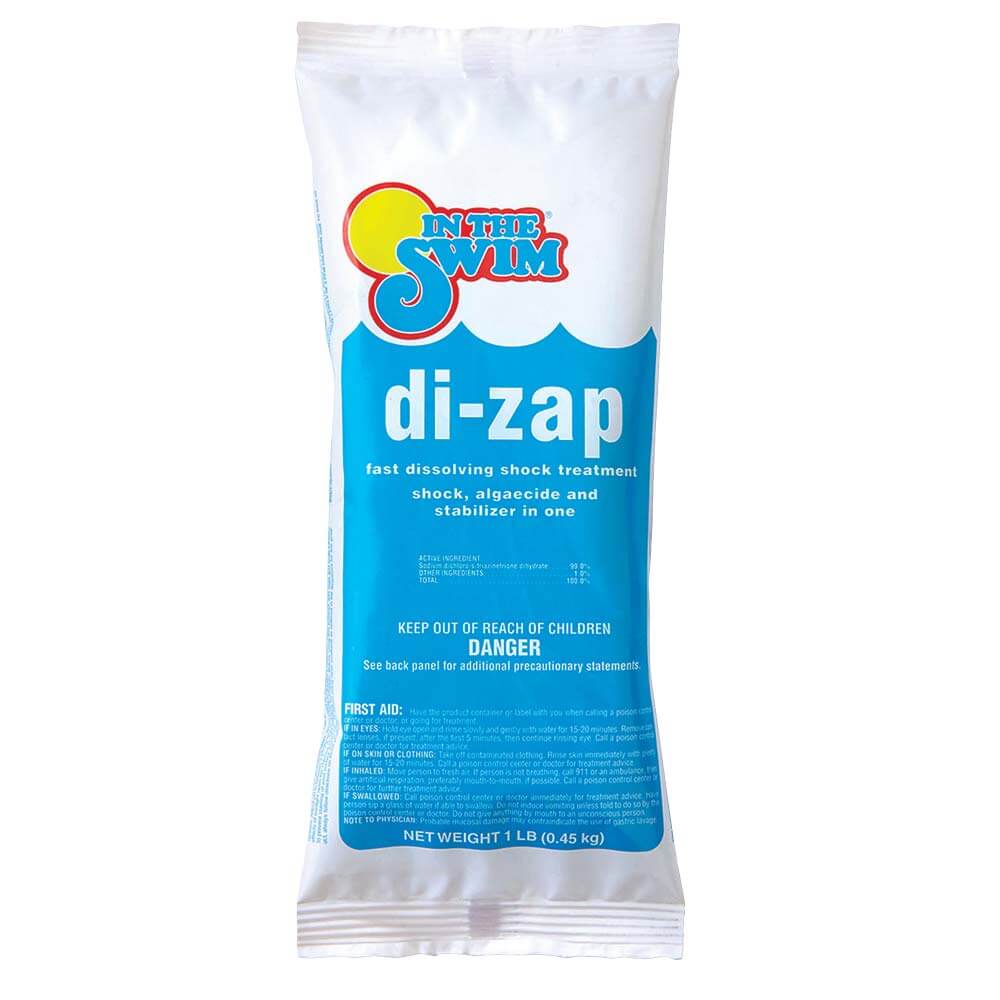

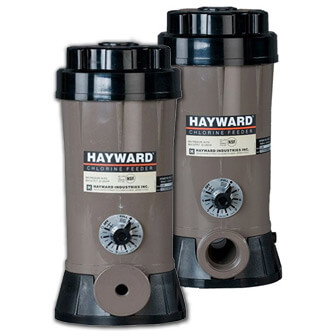


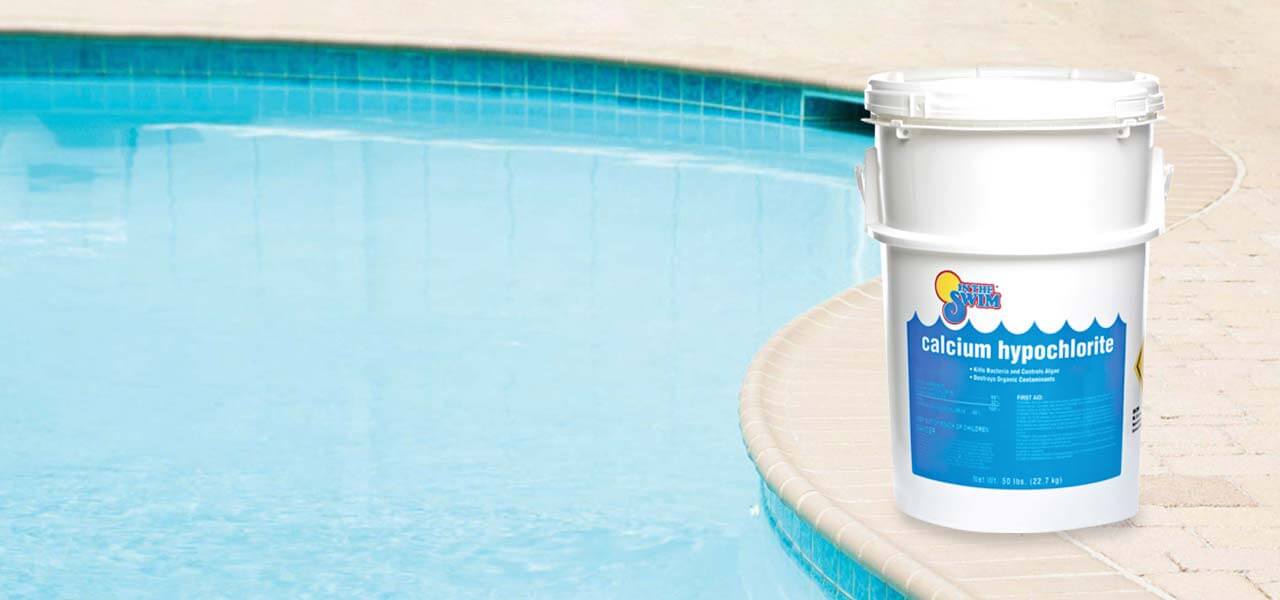

Hi there, I have a roughly 7200 gallon semi-unground pool. Will I be able to use the cl200 from Hayward? In the description it says for 50000L and more, but the pool company says it would not be a problem.
Sure that will not be a problem, just don’t add so many tablets to it, and keep the dial turned down low.
HI Dave, I have a Hayward inline (CL200)chlorinator that is 30 yrs old. My question is how long do they last?
thanks
mike
Hi Michael, I guess they last at least 30 years! With proper care and replacement of worn parts, they could essentially last forever. The lid o-ring and dial assembly may need replacement at some point, and you may need to clean out the tablet residue every few years, scraping the inside walls, and reaming out the standpipe and the small water intake hole on the opposite side. But yeah, if it ain’t broke, keep on keepin’ on!
Hi, I wonder if you would help. I have a chlorine dispenser that seems to be clogged. This is a Perform Max 960 off-line, Do I have to clean or change some parts, if so which one and how, or do I have to replace the complete unit, if so how do I replace it ? Also, the leaflet instructions is saying to never add any other types of chlorine, pH adjusters,shock treatments or algaecides through the skimmer but instructions that comes with the products I buy is saying to add through the skimmer. What must I do ?.Thanks and best regards.
Hello, you should not add caustic chemicals to the skimmer, but there are a few chemicals that are added thru the skimmer. Cyanuric acid or DE powder comes to mind. As for the chlorinator clog, you likely need to replace the entire Control Dial, but first you can try to remove it and possibly clean-it. It removes out of the housing by depressing center of locking pin, and pulling pin out of dial. See page 22 in the owners manual: https://www.kingtechnology.com/wp-content/uploads/download-manager-files/Performax%20Manual%20English%20Updated.pdf. If needed, the Control Dial is #5 on this schematic: https://www.intheswim.com/partsfinder/partsFinderByCategory.jsp?productId=SP_0215&category=Chlorinator%20Parts&categoryDimId=20128
Hi RJ
I am pretty new to the swimming pool world. I put a a 16X28 semi- inground pool for my grandkids. Last year we had a nightmare with alggie when we opened the pool, so I am thinking to have a chloreinator installed. the pool people that help me open the pool advise on the frog system, but i would like to have your opinion. cost and efficiency. Thanks so much in advance for your help.
Miriam, I love the Frog or Nature2 mineral system, but the Frog chlorine cartridges are just too expensive. I would recommend the Pentair model 300 inline chlorinator, using 3″ tablets, and the Nature2 Express> system, if you want to add the benefit of mineral purification, which is good stuff. You may also test the water for phosphates, since you mention algae problems, using PhosFree or other phosphate remover can help immensely. Also take a look at your filter, perhaps it is time to change the filter media, esp. after severe algae problems, bad sand or cartridges can help algae regenerate.
Hello, my question is what brand would you recommend for my 18×33 above ground pool when I comes to off line chlorinators. I’m looking at the power clean ultra or the perform-max . do any of these models allow you to change out chlorine tabs while the pump is running? I currently have the frog system with mineral pack and I think it’s cheaper in the long run to just buy chlorine and a chlorinator rather than the expensive frog back packs. I like the mineral system but if I go the route of a chlorinator I’ll just by the mineral pack that floats or goes in your skimmer. thoughts on all?
Hi Steve, I agree with the Bac-Pacs, too pricey, per pound. So just use a Frog mineral cartridge, or floater, or Nature2 Express is good too – along with tablet chlorine. For off-line chlorinators, I like the Perform-Max, and you can add tabs without shutting off pump, just turn the dial down to -0- and open the air bleeder knob. Power-Clean is good too, but think I like Performax a little bit better.
I have a 40,000 galleon inground pool. I currently use three floating buckets with 5-3” chlorine tablets. In hot summer months I hanebto refill the buckets every 10-14 days. Since I travel I’d like to have a feeder that has enough chlorine tablet capacity to allow me to refill it only once a month. I run my DT filter three hours a day and don’t want to increase that for fear of higher electric bills. Do you have a product that would achieve these goals?
Hi RJ, good question! Take a look at the Pentair Rainbow model 300-29 – or the other high capacity chlorinators on the same page. BTW, you would need less chlorine if you run the filter pump more. I would strongly urge you to run the filter a minimum of 8 hrs per day, but your choice of course!
My Rainbow Pentair 320 is leaking from the lid even when the dial is set to “off.” The O ring looks fine and I used lubricant. I’ve order a new O ring, which will take a week to arrive. Can there be another problem other than the O ring?
Hi, that should be it – the o-ring may be the problem. Inspect the threads on the cap and body also to make sure they are not broken, and be sure lid is tightened all the way. The raised parts on the lid are for help tightening, and loosening the lid.
I have a Hayward CL200 off line. It’s brand new and installed by the pool company. I have had it full of tablets and on full for 4 days now on a 17,200 gallon above ground pool. I have verified that water is coming out of the outlet line but my chlorine lever is only at 1ppm. I would like it at 3ppm. Do you think it just needs more time?
Hi Matt, assuming that the chlorinator is working properly, I would ask about the level of cyanuric acid, should be 30-50 ppm. I would also ask about how many hours per day the pump is running, as the chlorinator only works when the pump is on. It’s possible that the pool needs a good shocking, as there may be a high chlorine demand, or something consuming your chlorine. Aside from that, there could be an installation problem, with the chlorinator installed backwards, or the check valve fitting installed on the inlet and not the outlet side, or a crimped hose or a blockage of the internal standpipe or hose or fitting…
Will the Hayward inline Chlorinator work with a above ground pool using a intex 3000 GPH sand filter
that’s a good question Robert! Unfortunately I cannot find an answer. You could ask Hayward at 888-HAYWARD. I think it would work OK, but not 100% sure…
Davy: I have a Hayward inline (CL200). The folks that built my pool installed a bypass with a valve on the bypass. They indicated the valve should be partially opened because there is too much pressure drop across the chlorinator. However the installation documents indicate no need for this arrangement. Can you please provide an opinion and some guidance. I also have a difficult time controlling the chlorine dosing, could this arrangement be contributing to that challenge?
Thank you in advance.
Hi Barry, yes the owner’s manual does not mention when a bypass may be needed. But, if you notice the filter pressure jumping up dramatically, when the bypass valve is closed, that is the reason they would have installed it. The CL200 does have a fair amount of resistance – but, if your pressure is not rising more than a couple of psi with the valve closed, go ahead and close it all the way, and see if that helps the chlorine level stay consistent. Not normal to install a bypass on a Hayward chlorinator, I would not think it necessary, unless there is a very large pump used.
Can the online pentair be mounted below water line on my aboveground pool, and not over chlorinate?
Hi Scott, yes you can mount an In-Line chlorinator on an aboveground pool (below water level). The chlorinator will only chlorinate when the water is moving through the unit. Actually some chlorine will leach out when the pump is off too, but not so much as to over-chlorinate. If it does, you can just turn down the dial and/or put in fewer tablets.
Hi, I just puchased a Hayward CL220 off-line pool chlorinator. I also have a Hayward H200 gas heater that is installed approx. 50 ft. away from my pool pump and filter. The directions say to install inlet side of chlorinator between pump and filter and outlet side after filter. Ultimately, installation should be done after the pool heater. In order to do so, is it alright to install inlet between pump and filter and outlet approx. 32′ away with some 3/8″hose to the pool return line after the heater? or can I just install the off-line chlorinator on the return line after the heater? (there will be no pressure difference in the latter) need be? Thank you for any assistance you can provide.
Hi Ron, good question – you can install the chlorinator over by the heater, or after the heater. Install the Inlet hose on the pipe that runs to the heater, and install the Outlet hose on the pipe coming from the heater. I’m assuming that pipes are buried, or at ground level. Mount the CL220 on a heavy block of wood like a 6×6 or 1×12, or a cinder block set into the ground, to give you leverage when removing the lid.
Are their any chlorinators recommended for use in 2,250 gallon swimspa? Most I have seen are rated at 5000+ gallons. I am tired of the floating chlorinators or adding granule or liquid chlorine.
Hi Scott, you can use one that is rated for 5K, no problem there. Most chlorinators have 1.5″ ports, so you can install directly into an easily accessible pipe on the return side, after the pump filter and heater, just plumb it inline. I like the Sani-King spa feeders.
I have to replace my Hayward chlorinator every other year because the top freezes and leaks like a sieve – despite using a lubricant. Do all of these products have that problem, if no which ones are the best?
Hi Ron, it’s precisely because of lid problems that I prefer the Rainbow Pentair chlorinators. Or the CMP Ultra. Both lids are always positive sealing, AND easy to remove.
Hi there,
Do you know if all inline chlorinators need a check valve on the line? Are there any that don’t? For the offline version is a check valve needed on the main line do you know? Many thanks Nigel Heeler.
Hi Nigel;
A check valve is a one-way flow valve, to prevent chlorinated water from draining out of the In-Line chlorinator and slowly making its way back upstream (when the pump is off), and entering the heater, filter or other equipment. It is not always needed, and need not be, as long as the chlorinator is at ground level, and the other equipment in/out ports for heater or filter are 2 feet higher, off the ground. Use a check valve if your chlorinator is installed at the same level as the heater exit, mounted off the ground, or for heat pumps or cartridge filters, which often have in/out ports at ground level. All manufacturers may recommend a check valve, but it’s not really needed in any cases, as long as there is 1-2 ft. of vertical pipe between the chlorinator and other equipment, and the chlorinator is placed ‘last on the line’, after any other equipment, right before the return side valve (if any), and before the pipe turns down to go into the ground.